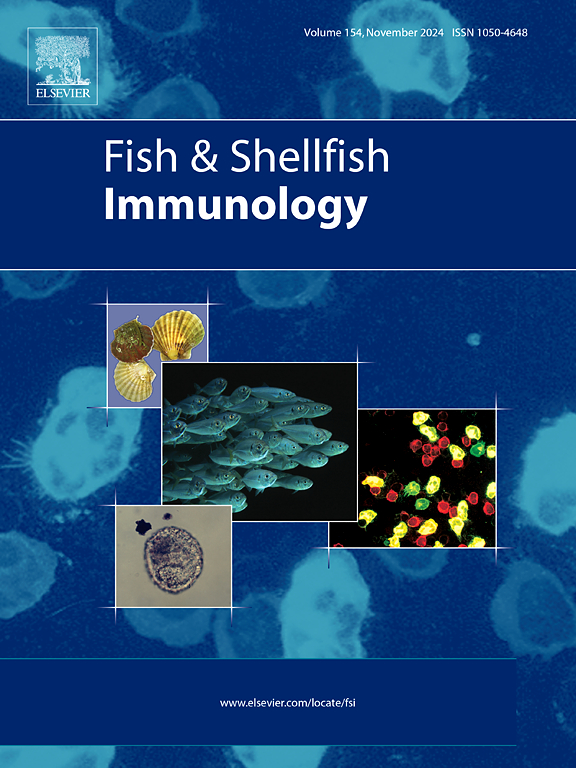嗜冷黄杆菌和杀鲑气单胞菌联合感染对虹鳟鱼死亡率、病理生理和免疫反应的协同作用
IF 3.9
2区 农林科学
Q1 FISHERIES
引用次数: 0
摘要
细菌合并感染对水产养殖构成重大威胁,与单一感染相比,往往导致更严重的后果。了解潜在的机制对于预防和控制疾病至关重要。本研究研究了嗜冷黄杆菌(Fp)和杀鲑气单胞菌(As)对虹鳟(Oncorhynchus mykiss)的单感染和共感染效果。结果表明,共感染组的死亡率明显高于单感染组,肝脏和肌肉组织的病理损伤更为严重。感染后第7天,合并感染组肝脏抗氧化酶(SOD和CAT)活性达到峰值,随后下降。转录组学分析显示,单Fp感染主要激活toll样受体信号通路,而单As感染激活MAPK信号通路。相比之下,联合感染(Fp+As)显示p53通路中DEGs的显著富集,表明一种独特的凋亡反应可能通过消除受损细胞来促进宿主防御。本研究表明,嗜冷f菌和杀鲑a菌的共同感染协同加剧了虹鳟鱼的疾病进展。这些发现提供了对合并感染风险的新见解,阐明了关键的免疫病理途径,并为制定水产养殖中有针对性的疾病干预措施奠定了科学基础。本文章由计算机程序翻译,如有差异,请以英文原文为准。
Synergistic effects of co-infection with Flavobacterium psychrophilum and Aeromonas salmonicida on mortality, pathophysiology, and immune responses in rainbow trout (Oncorhynchus mykiss)
Bacterial co-infections pose a significant threat to aquaculture, often leading to more severe outcomes compared than mono-infections. Understanding the underlying mechanisms is essential to preventing and controlling diseases. In this study, we investigated the effects of mono-infection and co-infection with Flavobacterium psychrophilum (Fp) and Aeromonas salmonicida (As) on rainbow trout (Oncorhynchus mykiss). Results indicated that the mortality rate in the co-infection group was significantly higher than that in the mono-infected groups, with more severe histopathological damage observed in the liver and muscle tissues. On day 7 post-infection, the antioxidant enzyme (SOD and CAT) activity in the liver of the co-infection group peaked and subsequently declined. Transcriptomic analysis revealed that Fp mono-infection primarily activated the Toll-like receptor signaling pathway, whereas As mono-infection activated the MAPK signaling pathway. In contrast, co-infection (Fp + As) showed significant enrichment of DEGs in the p53 pathway, suggesting a unique apoptotic response potentially contributing to host defense through the elimination of compromised cells. This study demonstrates that co-infection with F. psychrophilum and A. salmonicida synergistically exacerbates disease progression in rainbow trout. These findings provide novel insights into co-infection risks, elucidate key immunopathological pathways, and establish a scientific basis for developing targeted disease interventions in aquaculture.
求助全文
通过发布文献求助,成功后即可免费获取论文全文。
去求助
来源期刊

Fish & shellfish immunology
农林科学-海洋与淡水生物学
CiteScore
7.50
自引率
19.10%
发文量
750
审稿时长
68 days
期刊介绍:
Fish and Shellfish Immunology rapidly publishes high-quality, peer-refereed contributions in the expanding fields of fish and shellfish immunology. It presents studies on the basic mechanisms of both the specific and non-specific defense systems, the cells, tissues, and humoral factors involved, their dependence on environmental and intrinsic factors, response to pathogens, response to vaccination, and applied studies on the development of specific vaccines for use in the aquaculture industry.
 求助内容:
求助内容: 应助结果提醒方式:
应助结果提醒方式:


